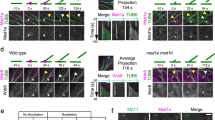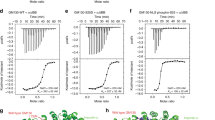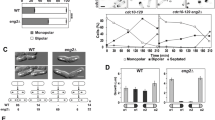Abstract
THE mad2-l mutation inactivates the cell-cycle feedback control that prevents budding yeast cells from leaving mitosis until spindle assembly is complete1. The gene product of MAD2 shows significant sequence similarity to the α-subunit of prenyltransferases2. Here we isolate a new temperature-sensitive mad2 mutant, mad2-2ts, and find that Mad2p is required for the membrane association of Yptlp and Sec4p, two prenylated small GTP-binding proteins involved in protein trafficking. Extracts from mad2-2ts mutant cells fail to geranylgeranylate a number of substrates at the non-permissive temperature. mad2-2ts is synthetically lethal with bet2-1, a mutation in the gene that encodes for the β-subunit of the Yptlp and Sec4p geranylgeranyl transferase3,4. Therefore MAD2 and BET2 gene products may physically interact to form a geranylgeranyl transferase complex. In addition, the difference between the phenotypes of mad2-l and mad2-2ts suggests that MAD2 has distinct roles in protein transport and the mitotic feedback control.
This is a preview of subscription content, access via your institution
Access options
Subscribe to this journal
Receive 51 print issues and online access
$199.00 per year
only $3.90 per issue
Buy this article
- Purchase on Springer Link
- Instant access to full article PDF
Prices may be subject to local taxes which are calculated during checkout
Similar content being viewed by others
References
Li, R. & Murray, A. W. Cell 66, 519–531 (1991).
Boguski, M., Murray, A. W. & Powers, S. New Biol. 4, 408–411 (1992).
Rossi, G., Jiang, Y., Newman, A. P. & Ferro-Novick, S. Nature 351, 158–161 (1991).
Kohl, N. E. et al. J. biol. Chem. 266, 18884–18888 (1991).
Finegold, A. A., Schafer, W. R., Rine, J., Whiteway, M. & Tamanoi, F. Science 249, 165–169 (1990).
Schafer, W. R. et al. Science 249, 1133–1139 (1990).
Glomset, J., Gelb, M. & Farnsworth, C. Curr. Opin. Lipidol. 2, 118–124 (1992).
Barnes, G., Louie, K. A. & Botstein, D. Molec. Biol. Cell 3, 29–47 (1992).
Bacon, R. A., Salminen, A., Ruohola, H., Novick, P. & Ferro, N. S. J. Cell Biol. 109, 1015–1022 (1989).
Segev, N. Science 252, 1553–1556 (1991).
Walworth, N. C., Goud, B., Kabcenell, A. K. & Novick, P. J. EMBO J. 8, 1685–1693 (1989).
Moya, M., Roberts, D. & Novick, P. Nature 361, 460–463 (1993).
Newman, A. & Ferro-Novick, S. J. Cell Biol. 105, 1587–1594 (1987).
Jiang, Y., Rossi, G. & Ferro-Novick, S. Nature 366, 84–86 (1993).
Alberts, A. W. et al. Proc. natn. Acad. Sci. U.S.A. 77, 3957–3961 (1980).
Havel, C. M. & Watson, J. A. Arch. Biochem. Biophys. 295, 410–420 (1992).
Armstrong, S. A., Seabra, M. C., Sudhof, T. C., Goldstein, J. L. & Brown, M. S. J. biol. Chem. (in the press).
Seabra, M. C., Reiss, Y., Casey, P. J., Brown, M. S. & Goldstein, J. L. Cell 65, 429–434 (1991).
Deshaies, R. J. & Schekman, R. 109, 2653–2664 (1989).
Guthrie, C. & Fink, G. R. Meth. Enzym. 194, 315–318 (1991).
Keller, R. K. J. biol. Chem. 261, 12053–12059 (1986).
Author information
Authors and Affiliations
Rights and permissions
About this article
Cite this article
Li, R., Havel, C., Watson, J. et al. The mitotic feedback control gene MAD2 encodes the α-subunit of a prenyltransferase. Nature 366, 82–84 (1993). https://doi.org/10.1038/366082a0
Received:
Accepted:
Issue Date:
DOI: https://doi.org/10.1038/366082a0
This article is cited by
-
Mrs6p, the yeast homologue of the mammalian choroideraemia protein: immunological evidence for its function as the Ypt1p Rab escort protein
Current Genetics (1994)
-
The yeast protein Mrs6p, a homologue of the rabGDI and human choroideraemia proteins, affects cytoplasmic and mitochondrial functions
Current Genetics (1994)
-
Bet2p and Mad2p are components of a prenyltransferase that adds geranylgeranyl onto Ypt1p and Sec4p
Nature (1993)
-
Proteins regulating Ras and its relatives
Nature (1993)
-
Mad Bet for Rab
Nature (1993)
Comments
By submitting a comment you agree to abide by our Terms and Community Guidelines. If you find something abusive or that does not comply with our terms or guidelines please flag it as inappropriate.



